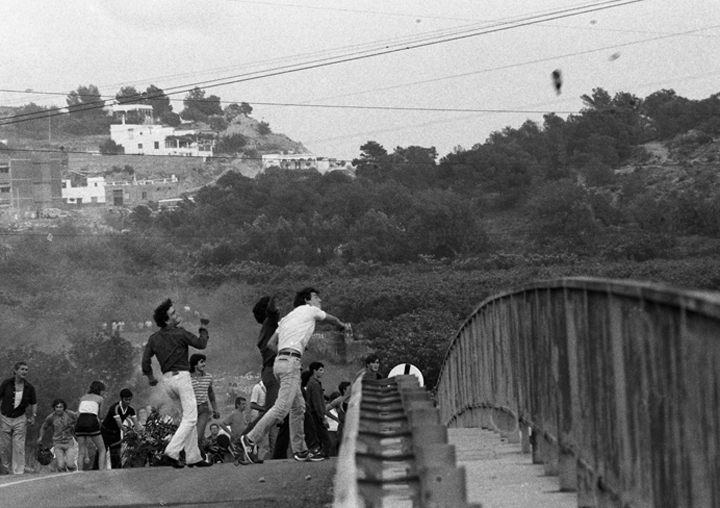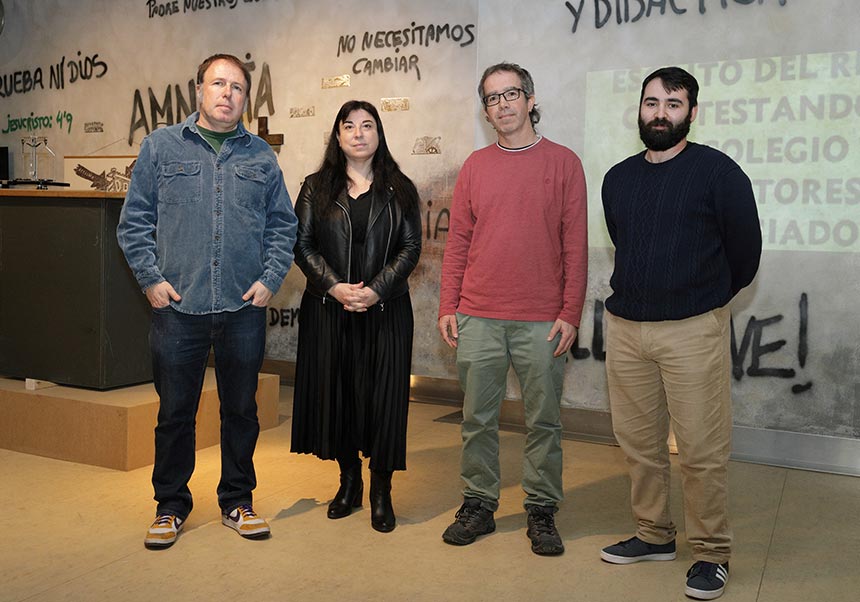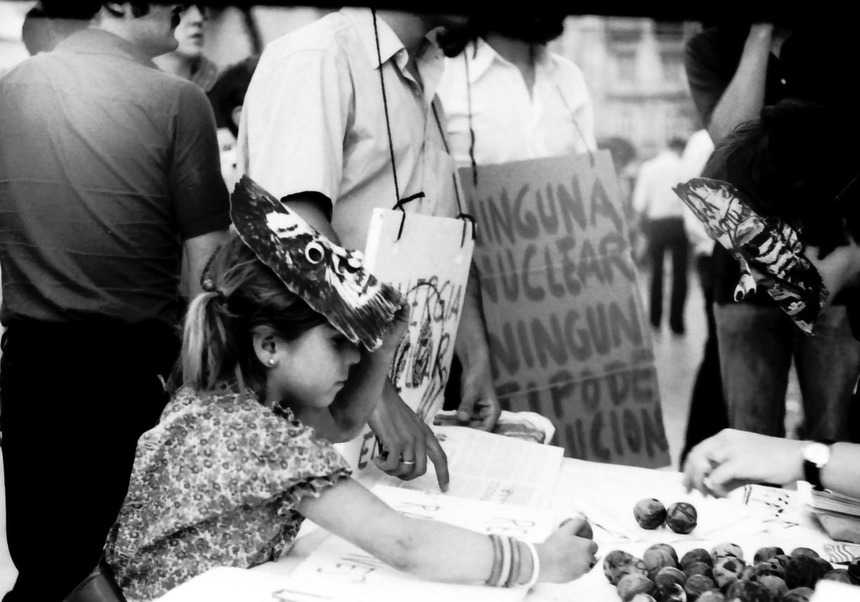UV’s La Nau presents the largest retrospective of Valencian artist Manuela Ballester, with more than 380 works from three different countries
- University Culture Service
- March 13rd, 2024
The Universitat de València presents the largest retrospective of the Valencian artist Manuela Ballester (Valencia, 17 November 1908 – Berlin, 7 November 1994) at La Nau Cultural Centre. To commemorate the 30th anniversary of her death and within the UV’s March for Eqality programme, the exhibition brings together more than 380 works and documents, as well as unpublished materials from Spain, Mexico and Germany, the three countries where the artist lived.
The opening ceremony, led by Maria Vicenta Mestre, Principal of the Universitat de València, took place on Tuesday, 16 March in the cloister of La Nau. The event included speeches by Ester Alba, the Vice-Principal for Culture and Society, Carmen Gaitán Salinas, the curator of the exhibition, and Natalia Enguix, first vice-president of the Provincial Council of Valencia and deputy of the Municipal Cooperation Area, specific delegate of Equality and Democratic Memory.
The Principal of the University requested a heartfelt round of applause as a tribute to exiled peoples, to those who supported them and to the countries that welcomed them, especially Mexico, where Manuela Ballester lived out her exile. The Principal highlighted different aspects of her character: a mother, a committed woman, a worker and a collaborator with Josep Renau. She described Manuela Ballester as a “multifaceted artist” who experimented with many artistic languages, such as drawing, engraving, mural painting and photography, applying them to different genres and subjects (portraits, landscapes, advertising, propaganda and fashion). At same time, she worked endlessly to provide for her family in exile and to defend the values of the Spanish Republic.
Manuela Ballester. Pintar frente a todo is the result of nearly a decade of extensive research. The exhibition is curated by Carmen Gaitán Salinas, senior researcher at the CSIC’s Department of Art History and Cultural Heritage. It hopes to enhance the understanding of the scope and significance of the painter’s artistic activity. It sheds light on unpublished works and is the first major retrospective of the artist. The exhibition brings together numerous works that present a wide variety of formats, languages and techniques from her extensive artistic production both in Spain and abroad. From Valencia to exile in Mexico, she experienced a life marked by paintbrushes, murals and personal struggle. The exhibition comprises portraits, magazine illustrations, editorial covers, fashion illustrations, posters, murals and advertising projects. These works are presented alongside photographs, publications and archival documents to create a better understanding of her multifaceted career.
Manuela Ballester, a member of the “Valencian generation of the 30s”, was a tireless creator who forged a legacy that transcends borders and eras. However, her work “was still awaiting deserved recognition,” as Gaitán Salinas stated in several publications on the prolific Valencian artist. “The exhibition’s title aims to reflect the challenges and obstacles – as Germaine Greer would say – that Ballester faced in her roles as a wife to an artist like Josep Renau, a mother of five children, and as someone who had to flee her homeland.” Her work has been crucial to “Spanish Modernism, for the Republic and, of course, for the contexts of exile,” Gaitán Salinas adds.
This exhibition is unique in that it is the largest retrospective of the artist’s work, with the Universitat de València as an intersection for her pieces. The curator and the UV faced the challenge of locating and registering Ballester’s wide-ranging artistic production from a total of 50 lenders, mostly private collectors, and brining it together in one place. Additionally, the exhibition is supported by the IVAM, the Valencian Provincial Council (Equality), the Josep Renau Foundation, the Ministry of Science and Innovation (Institute of History - CSIC) and the Ministry of Equality (Women’s Institute).
The exhibition occupies the Acadèmia and the general study rooms of La Nau and is divided into four sections. The tour begins in the Acadèmia, where visitors can explore the first three sections. These sections focus on the artist’s training and youth, her activity during the Republic and Spanish armed conflict, and finally, the wide range of artistic languages and media employed during her exile in Mexico. In the section dedicated to her artistic training, various documents have been found detailing how she began her training at the San Carlos School of Fine Arts and the time she most likely spent at her uncle Estanislao Vilaseca’s photogravure workshop. Also included are the first competitions she won, her initial editorial works such as the cover for Blanco y Negro magazine and her first canvases, such as the painting Mis hermanitas Rosita y Fina (1929). The exhibition includes some of her earliest, never-before-seen works, which have been located and borrowed specifically for this retrospective.
The second section of the exhibition focuses on the Spanish Second Republic and Civil War. It highlights the Ballester’s role during this period, despite her having a young son and giving birth to her second daughter in 1937. Manuela Ballester played an active role and was aware of the contributions women could make in the rearguard and in support of the Republican Front. In fact, she founded and directed the magazine Pasionaria in Valencia, which is also part of the exhibition. This section also features previously unpublished items, including the design of the poster Our strength is also necessary for victory (1938). In addition, it references the collaboration between the artist couple. This section features the front and back covers of an issue of the magazine Ejército del Ebro, for which Renau designed the front cover and Ballester designed the back cover.
The third section of the exhibition, My days in Mexico, focuses on Ballester’s 20-year exile in the country. It is one of the most extensive sections, featuring over 60 wall pieces, 70 showcase pieces, as well as vinyl records and other items. Ballester’s time in Mexico was highly prolific, with works created between June 1939, when the Renau–Ballester couple arrived in the United States, and August 1959, when Manuela decided to go into exile in East Germany, where Renau had already been living for a year. During this period, many of the works were commissions for the advertising workshop established by Renau, which helped him survive the crisis caused by exile. These projects varied in nature and sometimes involved Renau’s family. Examples include cinema posters and advertising works. This section also features Ballester’s work as an illustrator in numerous publications. This includes her artistic direction of the magazine Mujeres españolas, as well as her presence in the fashion industry and her talent as a portraitist. Ballester enjoyed representing her friends and, especially, her family. The exhibition has presents, for the first time, a collection of portraits of Manuela Ballester’s five children, which were painted between the summer and autumn of 1949. This was a complex task as the paintings of the five siblings are owned by different collectors. In addition, the exhibition features a charcoal portrait of José Puche, Principal of the Universitat de València, who was exiled to Mexico. Ballester painted this portrait in 1945 because he was a family friend.
The Estudi General Hall features the exhibition East Germany and other journeys. This collection includes around 80 wall pieces and approximately 35 showcases pieces, which depict the 35 years of Ballester’s life from 1959 to 1994. Despite settling in Germany with her two young children, the artist frequently travelled to Havana, Barcelona, Mexico and Valencia to visit her family and friends. In addition, she continuously travelled abroad to meet with her other children and siblings. This section presents four snowy German landscapes from different private collections for the first time. The collection includes numerous charcoal drawings of Berlin and various engravings with political and gentler themes, including those created for newspapers like España republicana. Similarly, the final section of the Hall contains numerous portraits, some of which have not been previously published, as well as brochures from Valencian galleries that exhibited Ballester’s works between 1975 and the early 1980s, along with other items.
With this retrospective on Manuel Ballester, the Universitat de València reaffirms its commitment to art in exile. The exhibition follows the 2007 showcase of Josep Renau (1907–1982): Commitment and culture, which established a precedent. Ballester is another significant figure from this period.
The exhibition is free to visit until 1 September and is accompanied by a detailed catalogue, which was created with the participation of nine researchers in art and exile and will be presented in June as part of an international seminar. It is also part of the extensive programme of cultural mediation activities titled Getting off the track!, which aims to help visitors understand and engage with the exhibition.
At the end of the exhibition opening, a concert was held featuring pianist Antonio Gallera and musicians from the UV Philharmonic Orchestra. The musical programme was based on the artist’s favourite music.
More information:
File in: Exposicions , Cultura , Centre Cultural La Nau
















